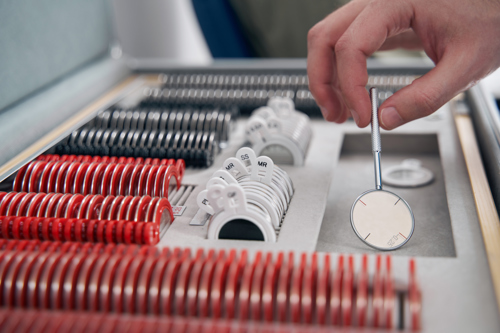Everyone's eyesight is different. To make glasses available to all, they are made with various lens types, materials, and coatings.
In this short guide, we'll quickly run through the main lens types and features available.
An Overview of Spectacle Lenses: Types and Options
The main lens types that your optician may offer you include the following:
Progressive lenses
Progressive lenses - also referred to as multifocal and varifocal lenses - can accommodate all eyesight types. You can use progressive lenses to view items clearly at various distances away - at the same time. They can also be used to resolve problems associated with astigmatism.
Some sections of progressive lenses are designed for viewing things close-up, while other parts are made for viewing things positioned far away.
Occupational lenses
Occupational lenses are reading glasses that are better equipped for short-distance occupational work. These are recommended for screen work and don't offer much distance vision.
Single vision lenses
Single-vision lenses are designed for one specific eyesight type, whether it be far-sighted, nearsightedness, or astigmatism. They are single vision in that they can only be used for one single eyesight type, unlike varifocal lenses.
Bifocal lenses
Bifocal lenses can be used to improve both long-sighted and short-sighted eyesight types. If you already have a long-sighted prescription and later notice that you also need near-sighted aid, you should consider bifocal lenses.
Instead of getting two separate pairs of glasses for near and far-sightedness, you can combine them into a single pair.
Unlike progressive lenses, bifocals can only accommodate two eyesight types.

Understanding Different Lens Materials for Glasses
There are also several types of lens material available for glasses, which include:
Plastic lenses
Plastic is the most common type of lens material thanks to its high durability. They're less likely to crack than glass lenses, which makes them better for kids and active adults. These are typically made using CR39 (Columbia Resin 39).
Another massive benefit of plastic lenses is their ability to block out 80% of UV light. They're also lighter and sit more comfortably on your face.
Glass lenses
Glass lenses are the clearest option for glasses. They create no visual distortion, which gives you sharper vision. Also, they don't scratch as easily as plastic. However, they do break a lot easier than plastic. They're also far bulkier, and don't provide the same high level of UV protection as plastic lenses.
High-index
High-index lenses are made from flexible plastic, which creates an extra thin spectacle lens. This is helpful in lens manufacturing as it allows for higher prescriptions to fit smaller frames.
Choosing the Right Lens Coatings and Treatments for Your Needs
If you need to book an eye appointment to get a new pair of glasses with a tailored lens design and coating, you can do it through Book an Eye Test. Book your styling consultation today!